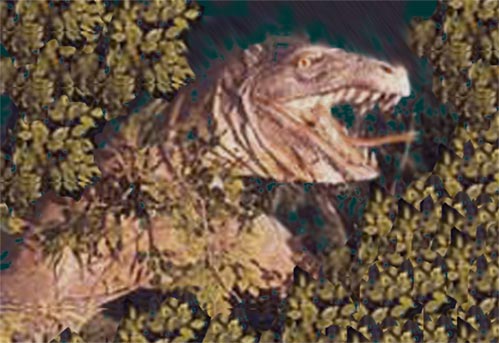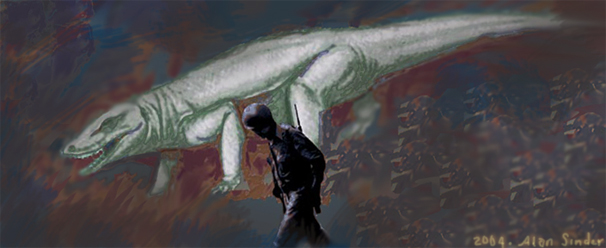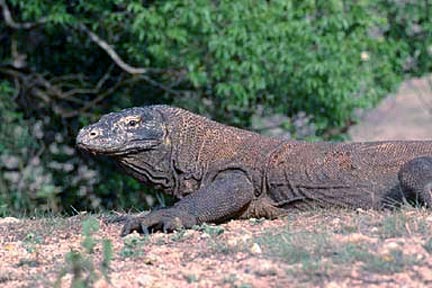Stephenson:Neal:Cryptonomicon:277:a sharpened Y...(Alan Sinder)
From the Quicksilver Metaweb.
a page for the giant lizard
Komodo dragons are dangerous to human beings!
Stephensonia
Of course, a Crypto book -- such as Cryptonomicon -- needs a cryptozoological encounter with a giant lizard. Chapter 9 opens with Bobby Shaftoe's observation: The marine raiders' bodies are no longer pressurized with blood and breath. The weight of their gear flattens them into the sand. The accelerating surf has already begun to shovel silt over them; comet trails of blood fade back into the ocean, red carpets for any sharks who may be browsing the coastline. Only one of them is a giant lizard. but all have the same general shape: fat in the middle and tailing off at the ends, streamlined by the waves. Then he encounters Enoch Root for the first time.
Authored entries
- Stephenson:Neal:Cryptonomicon:118:the good guys (Alan Sinder)
- Stephenson:Neal:Quicksilver:318:...the monster (Alan Sinder)
Wikipedia: Megalania Prisca
The Megalania Prisca was a giantsized bulky monitor lizard. A reptile reaching 30 feet in length and weighing at least 1,000 pounds or more. The Komodo dragon is roughly the size of a lion, but megalania was bigger than an average dairy cow. Extinct megalania is listed with the many casualties of the Ice Age. Or is it extinct? The creature has been sighted many times in the last century, and some sightings suggest that it lives also in New Guinea.

A Happy Ambush Predator
China Raider Bobby Shaftoe has a recurring nightmare involving a Big Lizard:
The rest of the platoon may or may not be dead; he thinks he can still hear some of them crying out, but it's hard to tell between the pounding of the incoming surf and the relentless patter of the machine gun. Then he realizes that some of them must be alive or else the Nips would not continue to fire their gun. Shaftoe knows that he is closer to the gun than any of his buddies. He is the only one who has a chance.
It is at this point that Shaftoe makes his Big Decision. It is surprisingly easy--but then, really stupid decisions are always the easiest.
He crawls along the log to the point that is closest to the machine gun. Then he draws a few deep breaths in a row, rises to a crouch, and vaults over the log! He has a clear view of the cave entrance now, the comet-shaped muzzle flash of the machine gun tesselated by the black grid of the net that they put up to reject incoming grenades. It is all remarkably clear. He looks back over the beach and sees motionless corpses.
Suddenly he realizes they are still firing the gun, not because any of his buddies are alive, but to use up all of their excess ammunition so that they will not have to pack it out. Shaftoe is a grunt, and understands.
Then the muzzle swings abruptly towards him--he has been sighted. He is in the clear, totally exposed. He can dive into the jungle foliage, but they will sweep it with fire until he is dead. Bobby Shaftoe plants his feet, aims his .45 into the cave, and begins pulling the trigger. The barrel of the machine gun is pointing at him now.
But it does not fire.
His .45 clicks. It's empty. Everything is silent except for the surf, and for the screaming. Shaftoe holsters his .45 and pulls out his revolver.
The voice that is doing the screaming is unfamiliar. It's not one of Shaftoe's buddies.
A Nipponese Imperial Marine bolts from the mouth of the cave, up above the level of Shaftoe's head. The pupil of Shaftoe's right eye, the sights of his revolver, and this Nip are all arranged briefly along the same line for a moment, during which Shaftoe pulls the trigger a couple of times and almost certainly scores a hit.
The Imperial Marine gets caught in the netting and plunges to the ground in front of him.
A second Nip dives out of the cave a moment later, grunting incoherently, apparently speechless with horror. He lands wrong and breaks one of his leg bones; Shaftoe can hear it snap. He begins running towards the surf anyway, hobbling grotesquely on the bad leg. He completely ignores Shaftoe. There is terrible bleeding from his neck and shoulder, and loose chunks of flesh flopping around as he runs.
Bobby Shaftoe holsters his revolver. He ought to shoulder his rifle and plug the guy, but he is too confused to do anything for the moment.
Something red flickers in the mouth of the cave. He glances up that way and sees nothing clear enough to register against the deafening visual noise of the jungle.
Then he sees the flash of red again, and it disappears again. It was shaped like a sharpened Y. It was shaped like the forked tongue of a reptile.
Then a moving slab of living jungle explodes from the mouth of the cave and crashes into the foliage below. The tops of the plants shake and topple as it moves.
It is out, free and clear, on the beach. It is low to the ground, moving on all fours. It pauses for a moment and flicks its tongue towards the Imperial Marine who is now hobbling into the Pacific Ocean some fifty feet distant.
Sand erupts into the air, like smoke from the burning tires of a drag racer, and the lizard is rocketing across the beach. It covers the distance to the Imperial Marine in one, two, three seconds, takes him in the backs of the knees, takes him down hard into the surf. Then the lizard is dragging the dead Nip back up onto the land. It stretches him out there among the dead Americans, walks around him a couple of times, flicking its tongue, and finally starts to eat him.
The name Megalania prisca means the ancient giant butcher. and this may certainly have been a fitting description for this large meat eater. Megalania belonged to the family that includes the goannas, or monitor lizards, the largest of which today is the Komodo Dragon found in Indonesia. Fossils of Megalania are comparatively rare. No complete skeleton has ever ever found. However several partial skeletons and other elements have allowed scientists to determine the size and structure of the animal. The large skull was equipped with numerous recurved, scimitar-like teeth.
Fossil skeletons suggests Megalania was a beefy animal, much more bulky than the Komodo Dragon and probably at least one third longer (4 to 5 meters). Like its modern counterparts Megalania probably scavenged from dead animals, but would have also been able to hunt and kill quite large prey. Komodo Dragons hunt by ambush and have been known to kill large deer, buffalo and even people. Whether Megalania killed Diprotodon, the largest of the megafauna is a matter of speculation; However it was capable of doing so.
It would also have competed for prey with other large carnivores such as the Marsupial Lion, Thylacoleo carnifex. The fossil record indicates that the geographic range of Megalania was quite broad including sites in Queensland, central Australia and New South Wales. Until recently this animal was not thought to have inhabited the southern part of the continent. However a fossil found at Naracoorte in 2000 extends its range much further.

Bobby Shaftoe's Nightmarish Big Lizard With Saberlike Septic Teeth
It is a beloved animal for cryptozoologists. The last sightings were from the 1970s. There have been sightings of large lizards in the Australian outback for some time. In 1961 three woodcutters were scared by a lizard they thought to be about 4 meters long. In July 1979, cryptozoologist Rex Gilroy[1] was called to a freshly-plowed field by a farmer. Across the field were 30 or so tracks from what looked like an enormous lizard. While most of the tracks had been ruined by rain, Gilroy was able to make a plaster cast of one that had been preserved. The footprint looked surprisingly like something that might have been made by a Megalania. While it sounds like a bigfoot sighting it is grounded in better scientific evidence.
Other incidents include a farmer who saw a lizard moving along the edge of his field. Using a set of fence posts as a guide, the farmer estimated the animal's length at seven to eight meters. A sighting of megalania arose in 1979, this time by the best possible witness Herpetologist Frank Gordon after conducting some field work in the Wattagan Mountains in New South Wales returned to his vehicle. After starting his engine he saw, what he at first thought was a log, scampering off. It ended up being a lizard of some 9 meters or more in length.
Megalania might not be constrained only to Australia some sightings suggest it may live in New Guinea. A French priest in the 1960's was traveling up river with a native guide in order to reach his mission. During the trip he spotted a large lizard lying on a fallen tree in the sun. He told the native to stop, but being badly frightened, the native continued the journey. The priest returned to the spot the following morning and measured the tree. It was ten meters long, yet the lizard almost matched it. The largest known Australian lizard is Varanus giganteus, a relative of Megalania and the Komodos. At six feet long and with a weight of thirty to forty pounds, though, it seems too small to explain these reports.
Then - Bobby's fatigue could have thrown his sense of scale off a tad. Scale doesn't matter when you're exhausted from battle. It could be the living Komodo dragon.
Komodo Dragons
The Komodo dragon (Varanus komodoensis) is the largest lizard in the world, growing to a length of 3 metres and weighing between 80 and 140 kg. It is a member of the monitor lizard family, Varanidae.
| Komodo dragon |
|---|
| Scientific classification |
| Kingdom: | Animalia |
| Phylum: | Chordata |
| Class: | Reptilia |
| Order: | Squamata |
| Sub-order: | Sauria |
| Family: | Varanidae |
| Genus: | Varanus |
| Species: | komodoensis |
| Binomial name | | Varanus komodoensis | |
Dragons have keen senses and are considered one of the most intelligent living reptiles. Lizards are reptiles of the order Squamata, which they share with the snakes. They are usually four-legged, with external ear openings and movable eyelids. Species range in adult length from a few centimeters (some Caribbean geckos) to nearly the three meters of the dragons
They are carnivores and hunt live prey, with a stealthy approach followed by a sudden short charge (they can run briefly at speeds up to 20 km/h). They have a strong bite augmented by severe infection of wounds, caused by the some 50 different strains of bacteria in their saliva.
Dragons eat any animals they can catch, up to the size of wild pigs, goats, and deer, and occasionally including human beings. Over a dozen deaths have been attributed to dragon bites in the last century.
Mating occurs between May and August, with the eggs laid in September. The eggs are protected, but the hatchlings (100 g and 40 cm in length) are not and most are eaten. Komodo dragons take around five years to grow to 2 metres in length and can live for up to 30 years.
There are around 6000 living komodo dragons, restricted to a few small islands in Indonesia , including the islands of Komodo (1700), Rinca (1300), Gili Motang (100) and Flores (maybe 2000).
The Komodo monitor was first reported by a European in 1910. The creatures were introduced to the rest of the world in a 1912 paper by Peter Ouwens, the director of the Zoological Museum at Bogor, Java.
With a view to the Fortean
Komodo Dragons (Varanus komodoensis) were one of the cryptozoological surprises of the 20th century. Before 1912 the species was completely unknown and large lizards were thought to be extinct. Then, in that year, a party of pearl fishermen anchored at an almost entirely-unknown isle in a chain of islands called the Lesser Sundas. The fishermen brought back stories of an enormous, prehistoric creature living there. The island's name was Komodo.
Head and Shoulders of a Komodo
Who'd have thought Jonny Quest was based on reality?
An expedition followed from the Buitenzorg Zoological Museum in Java. A report about the dragons was published, but received little attention in the years leading up to World War I. It wasn't until 1926 that an expedition from the American Museum of Natural History, under the leadership of W. Douglas Burden, traveled to this remote island to further investigate the dragons and, if possible, bring some back alive.
The expedition discovered that the stories were true. The largest of these lizards measured over ten feet from nose to tail. The males were the top predator on the island, capable of killing a water buffalo several times its weight. The Burden expedition, with considerable difficulty, managed to bring home twelve dead specimens and two live lizards.
The Komodo dragons still live on Komodo today and have also been discovered on several neighboring islands. Though there are as many dragons alive today as in 1912, they are still considered an endangered species because they have such a small habitat that an ecological disaster, like a single volcanic eruption, might wipe them out.
The dragons are dangerous to humans. A Swiss tourist who sat down to relax while the rest of his tour group went onward was attacked and eaten by a dragon. All that was left was a piece of his camera. A number of other people have been killed by dragon attacks over the years. These incidents are only few in number, but perhaps only because the dragons live in such isolated locations. The Island of Komodo has only 800 human inhabitants and double the number of dragons. Most of the other islands where the dragons live have no permanent human residents at all.
The dragons can eat up to 80 percent of their own weight in a single sitting. Their attack strategy is to wait in ambush, then rush forward and tear a single large bite from the victim. The victim soon collapses due to blood loss or later from the effects of the septic bacteria found in the dragon's mouth. Though most Komodo dragons prefer wild bore or deer as their meals, they will try to attack and consume almost every other animal they can find, including other dragons (Interestingly enough for reasons scientists still don't understand, the dragons are not susceptible to infections from the bites of other Komodos).
When the first expeditions landed on the island they recorded the largest male dragons to have a top weight of around 300 pounds. More recent studies have indicated that this figure is high,. probably due to the a substantial amount of undigested food in those specimens' stomachs. A more typical weight for the largest dragons is probably around 160 pounds. Though the Komodo's can see fairly well, they do most of their hunting based on smell. Also a dragon can detect the smell of carrion from a distance of several miles when the wind is right. Although they will hunt when they have to, these giant lizards are more than happy to consume an already dead animal when they come across one.
Komodos are very fast for short sprints and can scramble up a hill as fast as a man can run on level ground. They have huge curved claws and teeth similar in shape to a Tyrannosaurus Rex's. Like a snake they can stretch their jaws to swallow large chunks of their victims. The Komodo's defense includes a thick skin with heavy folds that make the lizard look as if it is wearing a suit of chain mail armor. They are also one of the smartest lizards and their eyes seem to hold a primal, but clear intelligence.
Komodos remain the top predators on the island instead of an animal like the tiger because of their metabolism. The Komodo Dragon, like most reptiles, is cold-blooded. This means it doesn't maintain a constant body temperature, but is dependent on the sun to warm it up enough in the morning so it can take on vigorous activity.
Tigers are warm-blooded and maintain a constant body temperature at all times. This allows them to be active no matter what the temperature or time of day. Animals who are warm-blooded burn much more energy than cold-blooded ones. This means they must eat more. Scientists think that islands like Komodo are just too small and have too few prey animals to feed a population of warm-blooded, high-energy tigers, but can support the lower energy demands of the cold-blooded dragons.
Historical Dragons
... In the main ports of call, Nikki [Alford] and the rest of the team are setting Rex [Warner] a quest based on the six hundred year old diary of Ma Huan, who sailed on three of Zheng He's seven voyages. The second quest: In Melaka, to find what Ma Huan describes as an Iguana Dragon - an animal which is covered with scales, has a dragon's head, and which bites men! ...[2]